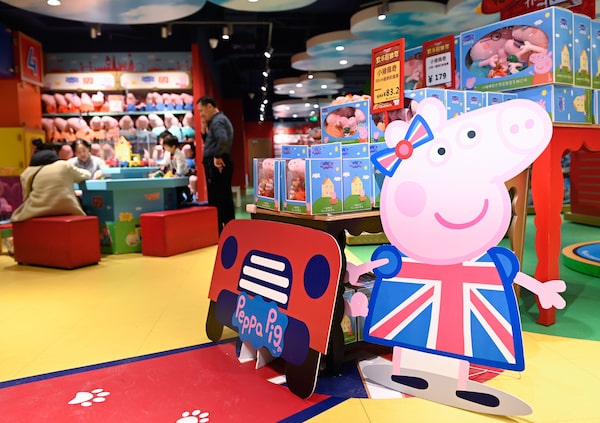
A billboard of Peppa Pig is displayed at a toy store in Beijing.WANG ZHAO/AFP/Getty Images
Can Bill C-11, the proposed federal online streaming act, save my son from the nefarious influence of Peppa Pig and Bluey?
That British cartoon pig and Australian anthropomorphic animated dog – and the very popular and bingeable short shows they star in – have definitely been leading my three-year-old Canadian son astray.
Linguistically, I mean. Well, mostly linguistically. I am also a little concerned that the fact my preschooler says “satnav” instead of GPS might cause him problems asking for physical directions around the neighbourhood in the future, too.
10 TV shows you’ll actually want your kids to watch
Books for kids: 27 titles for every type of young reader
“Satnav,” short for “satellite navigation,” is one of dozens of British or Australian English expressions that Dash – who, sorry, this just in, is actually “nearly 4” – uses because Peppa Pig and Bluey have been in constant rotation on Netflix or Disney+ during screen time in our household over the past two years.
My son calls almost everything “cheeky” and asks whether he can “have a go” rather than a turn. I’ll pick him up from daycare and hear that he had “lovely” time playing in the “sand pit.” He sometimes use British words such “pedalo” that I have to look up if I wasn’t paying close enough attention to a particular placid porcine adventure of Peppa.
We’ve had visitors ask where Dash got his “accent” from. I gather we are not alone in this, either. There was a flurry of articles about North American kids starting to sound British because of Peppa at the height of the pandemic, when screen time was high and entertainment news was in short supply.
But even now that my son has friends beyond his immediate family and the television set, he still can sound like an orphan child we’ve adopted from the streets of Southhampton, or Sydney.
This isn’t exactly driving our family apart. But while I say to-may-to, Dash says to-mah-to, and he doesn’t want them on his burger (pronounced “buh-guh,” thanks to Bluey).
Maybe my expectations for Canadian-specific kids content featuring local cultural references and this country’s wide range of accents is too high. I grew up in the 1980s without cable or a VCR – just a television with a couple of dials and rabbit ears that brought it whatever happened to be on the two English channels we could receive over the air in Montreal.
So that meant that the CBC was on almost every morning, and I was inculcated into my country’s culture by watching a lineup that was populated almost entirely by Canadian puppets and humans.
Mr. Dressup and Fred Penner were my main televisual companions, though I caught the final seasons of The Friendly Giant (look up, waaaay up!) and the first of Under the Umbrella Tree.
Will Bill C-11 and its updating of Canada’s broadcasting laws for the streaming era help my family deprogram my little one before he does something rash like take a gap year in the Antipodes?
Probably not. Canada is already a world leader in making animated series for kids – it’s just that very little of this CanCon is as clearly Canadian in content as Bluey is explicitly Australian or Peppa Pig is culturally British.
Paw Patrol, for instance, is one of the biggest cultural phenomena for preschoolers the world over. But you’d be hard pressed to know the show’s country of origin is Canada if not for the occasional tell such as the sight of a Robertson-head screw.
The reason for this is that Canadian animation studios make their money by selling to the American market – and from there the world. (Though Paw Patrol’s Canadian voice actors are replaced by British ones for broadcast in Great Britain.)
The CBC has its own streaming service these days, of course: Gem. It has plenty of these nebulously Canadian cartoons, including Paw Patrol and Daniel Tiger’s Neighbourhood (which haven’t grabbed my son for some reason), as well as, to be fair, some such as Teepee Time that are more culturally specific.
But my family hasn’t spent that much time on Gem as it seems more interested in upselling adults to its ad-free Premium service than truly serving my son’s generation.
CBC Gem Kids programming has its own tab and no ads by default, but you can’t leave a preschooler who somehow knows how to use your Apple TV remote better than you do alone with it for a second or they might end up in the adult content. There are no parental controls or kids accounts such as those you’ll find on Disney+ or Netflix.
Better funded public broadcasters in other countries, such as the BBC in Great Britain and ABC in Australia (source of Bluey), have separate apps for children viewers. (TVO, the small Ontario public broadcaster, has its own kids streaming app too.)
Ultimately, Bill C-11 could make more Canadian-produced kids shows available on more streaming services. But I’m skeptical that it can turn back time to my two-channel youth, when Mr. Dressup ruled supreme, or to a time when the CBC better understood that its purpose in cultivating Canadian identity started with kids.
Plan your screen time with the weekly What to Watch newsletter. Sign up today.